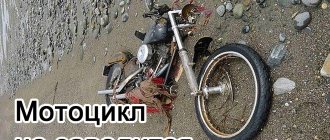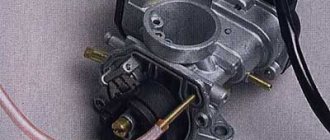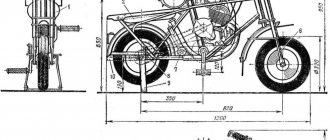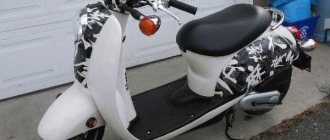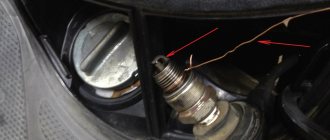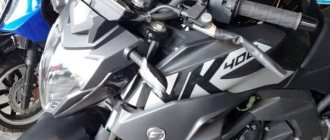The engine is the most complex system of any motorcycle, which is most susceptible to negative environmental influences. If your Minsk motorcycle does not start after a major overhaul, winter downtime, or for no apparent reason after an hour-long stop somewhere along the road, then this article is just for you.
The reasons for a motorcycle engine failure and the conditions leading to it may be different. Performing the following simple steps can help you quickly find and fix the problem without the help of specialists.
Why does the Minsk motorcycle not start?
The engine is the most complex system of any motorcycle, which is most susceptible to negative environmental influences. If your Minsk motorcycle does not start after a major overhaul, winter downtime, or for no apparent reason after an hour-long stop somewhere along the road, then this article is just for you.
The engine is the most complex system of any motorcycle, which is most susceptible to negative environmental influences. If your Minsk motorcycle does not start after a major overhaul, winter downtime, or for no apparent reason after an hour-long stop somewhere along the road, then this article is just for you.
The reasons for a motorcycle engine failure and the conditions leading to it may be different. Performing the following simple steps can help you quickly find and fix the problem without the help of specialists.
Spark test
To check the Minsk motorcycle, you need to remove the spark plug and unscrew the spark plug. Next, you should immediately determine (wet or dry) the spark plug contact.
If the contact is wet, then most likely there is a problem with the spark plug in your motorcycle. If the contact is dry, then you should look for a problem in the carburetor.
Since the spark plug has already been unscrewed, you can diagnose and verify its functionality. Before checking for a spark, the correct gap between the spark plug electrodes should be set.
According to the technical recommendation of the Minsk motorcycle manufacturer, the required gap should be from 0.4 to 0.7 mm, depending on the model. The gap is set using a feeler gauge, which can be purchased at any auto or motorcycle parts store. If you work on the Minsk motorcycle yourself, then this tool should already be in your kit.
To check the spark on a removed spark plug:
- insert the candle into the candle holder;
- short-circuit the spark plug body to ground;
- activate the winding stem.
Attention! When checking the spark plug, you must hold it only by the installed candle holder, otherwise electric shock may occur.
It should also be noted that spark is different. The correct working spark should always be the same, clearly visible, and always pass in the same place.
If a spark does not jump between the contacts of the spark plug, then it is necessary to check again, but using a different spark plug. If after re-checking a spark appears, this indicates that the installed spark plug was faulty and should be replaced. If there is still no spark, then you need to check the ignition system of the Minsk motorcycle.
Preliminary inspection of a motorcycle Minsk
Everyone understands that for stable operation of a motorcycle engine it is necessary that the required amount of fuel enters the cylinder. It is also required that there is a good spark at the spark plug contacts.
If the Minsk motorcycle does not start, this means that fuel is not entering the combustion chamber or there is no spark. You should not rush to unscrew the spark plug or remove the carburetor, but rather listen to the opinion of experts who recommend starting to eliminate this problem with a simple inspection.
When inspecting a Minsk motorcycle, you need to check the following:
- the presence of gasoline leaks on the hoses and the engine, after making sure that the gas tank tap is open;
- presence of parts of damaged motorcycle electrical wiring.
If an inspection of the motorcycle does not reveal possible causes of the malfunction, then you need to move on to the next step.
Checking the fuel system
Checking whether fuel is entering the carburetor is much easier than checking whether there is a spark at the spark plug. To do this, after making sure that the gas tank tap is open, you need to press the carburetor float release. If after 30 seconds of waiting the fuel still does not flow, you should pay attention to the following:
- make sure there is fuel in the gas tank;
- check if the gas tank tap is clogged with any debris;
- Check to see if gasoline flows freely through the fuel hose.
If you managed to fill the carburetor with gasoline, you can safely try to start the motorcycle. But if the engine still fails to start, then you need to check for a spark at the spark plug.
Operating principle of the electronic ignition system
The latest generation of Minsk generators significantly increases the power of the electricity source. This ensures uninterrupted functioning of all elements of the system. In all speed modes, electricity consumers have reliable supply.
New generators differ not only in their functionality, but also in their structure. Different motorcycle models have different types of alternators. But they are similar in appearance, which allows you to attach them without matching the model.
Carburetor problems
So, you are the owner of a Minsk motorcycle, the carburetor of which regularly receives gasoline, and the spark plug provides a spark sufficient for stable operation of the engine.
But this is not enough for the motorcycle to start. An unscrewed dry spark plug showed that the problem was in the carburetor, namely, the incoming fuel could not reach the combustion chamber of the cylinder. In this case, it is necessary to remove and clean the carburetor.
To clean the carburetor, it must be removed by disconnecting it from the cylinder and air filter. You also need to disconnect the throttle cable and gasoline hose. To prevent dirt from getting inside the carburetor, before further disassembly you must not be lazy and completely clean it.
It is necessary to disassemble and reassemble the carburetor cleanly, since dust or dirt particles getting inside will lead to unsatisfactory operation of the motorcycle engine even after washing it.
Upon completion of disassembling the carburetor, it is necessary to clean all its parts from accumulated dirt, and also blow out all channels and the jet with a compressor. It will not be superfluous if you additionally blow out the air filter and gas tap.
After completing all the manipulations, you need to install the carburetor in place. During assembly, as well as during disassembly, it is necessary that no dirt gets inside the carburetor.
After installation, make sure that the carburetor fits tightly to the cylinder. If you did everything correctly, you can be sure that after some effort your Minsk motorcycle will be able to start.
Why is there a weak spark on a motorcycle?
You should not immediately “blame” the ignition system for the malfunction. As practice shows, it fails and provokes the problem of a weak or irregular spark much less often than the wrong fuel mixture gets into the tank. Either too lean (for example, after a long period of inactivity), or too rich (if the fuel from the float chamber has managed to wet the cylinder).
There are often cases when, in the process of troubleshooting, the driver simply discharges the battery. And now the battery cannot produce enough voltage to produce a spark. This should be taken into account when repairing a motorcycle.
If you are sure of both the quality of the fuel and the condition of the battery, check all wires and contacts, as well as the breaker contacts and the capacitor. Sometimes the reasons for a weak spark on a motorcycle are hidden precisely in the lack of stable contact between the conductors. By the way, cleaning the candle itself can also help, although it must be done carefully.
Sometimes, even quite often, the problem lies in the development of the plug on the coil. The plug itself can be replaced or slightly crimped. And the contact must be cleaned. If this does not solve the problem, then you will have to continue the search inside the coil and high-voltage wire. If the motorcycle has a weak spark:
● check the resistance between the low-voltage terminals of the coil - it should not exceed 1 Ohm;
● Next, you should measure the resistance between one of the low-voltage terminals and the high-voltage one - it should already reach a kilo-ohm.
Worth knowing! If you need to replace the ignition coil to check for spark, you can install any analogue from a 12-volt, non-injected motorcycle. Or even take a reel from a Zhiguli car.
If your motorcycle runs on a multi-cylinder engine, one of the cylinders simply refuses to work, you can recheck all the elements of the ignition coil using a simple method of selecting serviceable/faulty parts. As a last resort, you can turn off one of the three cylinders (which turns out to be faulty) and drive to a garage or repair bay. To do this, you need to disconnect the cable from the carburetor or open the contact on the injector.
Checking cylinder compression.
If the Minsk motorcycle still does not start, then you need to check the compression. To do this, you need to unscrew the spark plug and pour a few grams of gasoline directly into the cylinder through the vacated hole.
Next, tighten the spark plug and try to start the motorcycle. After this, the engine should start and after running at full speed for a few seconds, stall.
If the motorcycle starts, then you should move on to more careful adjustment of the carburetor. Namely, using the appropriate bolts, try to adjust the opening of the idle air damper and adjust the proportions of the mixture entering the combustion chamber.
If the Minsk motorcycle does not start, there is a spark - this means that the mixture entering the combustion chamber does not reach the required compression and does not ignite.
There are many reasons why there may be no compression in the cylinder of a Minsk motorcycle:
- If the engine is equipped with valves, you may need to check for cracks on them. Also, the valves may not fit tightly to the “seat” or it may have quite a lot of wear.
- Burnout of the cylinder head gasket due to wear;
- Cylinder seizure due to engine overheating;
- Severe wear on the cylinder or piston;
- The cylinder rings have collapsed or are not installed correctly;
- Cracks have formed on the piston or cylinder due to long use;
- For engines equipped with valves, the gas distribution valve circuit may be broken, or this mechanism may not be installed correctly.
POSSIBLE MALFUNCTIONS OF THE MOTORCYCLE "MINSK" MMVZ 3.111
Signs of a malfunction
| Causes | Remedies | |
| ENGINE | ||
| Engine won't start | “Overshoot” when trying to start the engine, or due to a leak in the carburetor needle valve while parked. | Blow out the crank chamber and cylinder |
| Clogged carburetor channels, air filter, gas tap, or holes in the gas tank plug | Clean out | |
| Water getting into fuel | Replace fuel, clean the power system | |
| The carburetor idle system is not adjusted | Adjust the carburetor | |
| Ignition installed incorrectly | Adjust the ignition | |
| Formation of a jumper between the spark plug electrodes | Clean the spark plug | |
| Crack in spark plug insulator | Replace the spark plug | |
| Capacitor broken | Replace the capacitor | |
| The breaker contacts are burnt | Clean the contacts | |
| The engine does not develop speed | Poor quality gasoline | Change fuel |
| Mixture too rich due to stuck float | Clean the carburetor | |
| Late ignition | Adjust the ignition | |
| Formation of a jumper between the spark plug electrodes | Clean the spark plug | |
| Clogged air filter or high oil level in the oil filter | Rinse the filter and fill with 50 cm3 | |
| The gap between the air filter cover and the fungus is small | Increase the gap to 5-7 mm | |
| Muffler clogged with carbon deposits | Clean out | |
| Carbon deposits in the cylinder exhaust port | Clean out | |
| Capacitor broken | Replace | |
| The engine develops low power | Leakage of the cylinder or crankcase due to damage to gaskets or seals | Replace the gasket or seal |
| Incorrect carburetor adjustment | Adjust the carburetor | |
| Incorrect ignition system adjustment | Adjust the ignition system | |
| Muffler clogged or deformed | Clean or replace | |
| Carbon deposits in the exhaust window or ring deposits | Clean out | |
| Wear of piston group and cylinder parts | Replace worn parts | |
| Engine misfires | The fuel system is clogged or water gets into the fuel. | Clean the power system |
| The gap between the breaker contacts is incorrectly set | Adjust the gap | |
| The breaker contacts are burnt | Clean up | |
| Carbon deposits on the spark plug, or a bridge between the spark plug electrodes | Clean the candle | |
| The engine suddenly stops | Power system clogged | Clean out |
| Malfunction of the ignition system | Check the spark plug, the fastening of the wires, the condition of the breaker contacts, the ignition coil, see “the engine is overheating” | |
| Late ignition | Adjust the ignition | |
| Carbon deposits on the cylinder head and piston crown | Remove carbon deposits | |
| Contamination of cylinder head fins | Clean the cylinder fins | |
| Connecting rod bent | Straighten the connecting rod | |
| Low oil content in the mixture | Change fuel | |
| Shots into the air filter | Crankcase leakage due to wear of crankshaft seals | Replace seals |
| Lean mixture due to clogging of the power system, or improper carburetor adjustment | Clean the power system and adjust the carburetor | |
| Early ignition, or small gap in the breaker | Adjust the ignition | |
| Silencer shots | Rich mixture due to stuck float needle or incorrect carburetor adjustment | Clean the float chamber or adjust the carburetor |
| Late ignition, or small gap in the breaker | Adjust the ignition | |
| Air filter clogged | Rinse the filter | |
| Wear of crankshaft seals | Replace seals | |
| Increased exhaust smoke and excessive fuel consumption | Damage to the gasket between the crankcase halves (oil getting into the crank chamber from the gearbox) | Replace gasket |
| Rich mixture | Clean and adjust the carburetor | |
| Air filter clogged | Rinse | |
| Increased oil content in the mixture | Change fuel | |
| Extraneous noises and knocks are heard in the engine | Early ignition | Adjust the ignition |
| Wear of parts of the crank mechanism and cylinder-piston group | Replace worn parts | |
| Broken piston rings or piston, piston pin retaining rings falling out | Replace parts | |
| Unscrewing the nut securing the drive gear of the motor transmission or the driven clutch drum | Tighten the nuts | |
| Detonation due to the use of low-quality gasoline | Change fuel | |
| The generator rotor touching the stator | Check the fastening of the rotor and stator | |
| Reduced oil level in the crankcase | Check the gearbox oil level | |
| Symptoms of a problem | Causes | Remedies |
| GEARBOX | ||
| The transmitters do not turn on or turn off on their own | Loosening the shift mechanism base screws | Tighten the screws |
| Seizing of pawls in the housing | Rinse the pawl body | |
| Chipping or broken cams or gear teeth | Replace broken parts | |
| Insufficient number of shims between the right intermediate shaft bearing, the output shaft bearing and the output shaft oil seal cover | Add the required number of washers | |
| Symptoms of a problem | Causes | Remedies |
| CLUTCH | ||
| The clutch is moving or slipping | Incorrect clutch adjustment | Adjust |
| Clutch is not adjustable | Loosening the pressure springs, pulling the cable | Replace springs or cable |
| Clutch won't disengage | Discs jamming on splines, driven drum nut loosening | Check the mobility of the discs, tighten the nut |
| Clutch won't engage | Disengagement of the pressure plate from the clutch driven drum | Reinstall the disk in its original location |
| Symptoms of a problem | Causes | Remedies |
| BRAKES | ||
| Brakes don't hold | Oiling the linings | Replace the oil seal |
| Protrusion of rivets above the overlays | Replace pads or linings | |
| Water getting into the brakes | Dry the brakes by periodically applying the brakes carefully. | |
| Self-braking | Incorrect pedal or lever adjustment | Adjust the free play of the pedal or lever |
| Insufficient pedal or cam lubrication | Lubricate | |
| Rear brake pedal falls off | Broken spline on lever or cam | Replace the lever or cam |
| Insufficient tightening of the nut on the brake rod | Adjust the tightening of the nut | |
| Symptoms of a problem | Causes | Remedies |
| FRONT FORK | ||
| Knock in the front fork | Bearing play in the steering column, column | Set the play by tightening the bearings |
| Play in the fork legs in the yoke due to unscrewing the tightening nuts. The front guard or headlight of the motorcycle is loose. | Eliminate play by tightening the nuts | |
| Severe wear on fork leg tube bushings | Disassemble the fork, replace defective parts | |
| Poor fork damping, repeated hard impacts | Lack or lack of oil in the fork legs | Find the cause of the oil leak, fix the problem, fill the feathers with oil |
| Oil leak from fork | Worn or damaged fork leg seals | Replace defective seals |
| Symptoms of a problem | Causes | Remedies |
| REAR WHEEL SUSPENSION | ||
| There is a lot of oil coming out from under the lower casing. | Rod seal is broken | Replace the oil seal with a new one |
| O-ring rupture | Replace the ring with a new one | |
| The nut is not tightened all the way | Screw the nut all the way | |
| The oil seal is not seated correctly in the nut | Turn the oil seal over | |
| Scratches on the rod | Replace the rod with a new one | |
| The threads of the nut and body are broken | Replace the damaged part | |
| Knocks when the shock absorber operates | Lack of shock absorption fluid | Re-assemble the shock absorber and fill it with shock-absorbing fluid |
| Low viscosity of shock-absorbing fluid | Overhaul the shock absorber and fill it with the appropriate fluid. | |
| The piston valve does not fit tightly onto the piston | Reassemble the shock absorber, wash it, check the condition of the valve | |
| Piston worn or damaged | Reassemble the shock absorber, replace worn parts | |
| The rubber bushings of the tips are destroyed | Replace the bushings with new ones | |
| Upper casing misalignment | The rod has come unscrewed from the tip | Screw in the stem and seal |
| Main spring failure | Change the spring | |
| Spring catching on glasses | Lubricate friction points | |
| Creaking sound when shock absorber operates | Spring settlement | Change the spring |
| Filled with thick liquid | Fill with appropriate fluid | |
| Suspension works hard | Rod bent | Change the rod |
| The oil seal spring is skewed | Check the suspension and fix the problem. | |
content .. 31 32
We measure compression
Compression is the pressure in the cylinder at the end of the compression stroke. The magnitude of this pressure allows you to assess the condition of the engine. A working Alpha moped engine should have a compression of at least 8-10 kg/cm² (“atmospheres”) . If it is less, then the engine is faulty: either the piston rings are worn out or the valves are leaking. Most likely the engine will need to be disassembled.
Compression is measured using a compression meter - a special pressure gauge that is inserted or screwed in (depending on the design) instead of the spark plug.
Before measuring compression, it is advisable to warm up the engine, but if it does not start, you will have to measure it cold. It is also advisable to unscrew the carburetor or open the throttle valve and turn off the fuel supply.
The engine must be rotated using an electric starter or kickstarter until the compression meter readings stop increasing.
When the compression is less than 8 atmospheres , you need to pour 10-15 ml of engine oil into the spark plug hole using a syringe. If after this the compression increases noticeably, it means the piston rings are worn out . If not, then the problem is in the valves or camshaft drive . The most common reason: the camshaft drive chain is broken or has slipped, or the valves are bent/broken.
